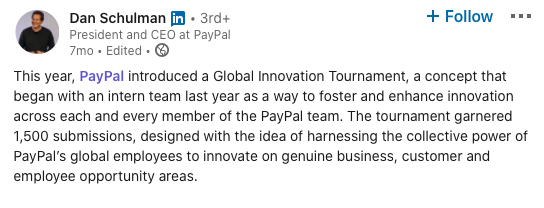PayPal

Project Overview
- Duration: January 2019 - May 2019, August 2019 - December 2019
- Team: Data science consulting team composed of 2 Project Managers and 6 Data Analysts
- My role: Project Manager
- Tools & Frameworks: Python, Jupyter, pandas, matplotlib
In the spring and fall of 2019, I got the opportunity to co-lead a data science team tasked with improving employee engagement at PayPal through data-driven recommendations for their internal rewards system. The PayPal Innovation Lab had recently developed a cryptocurrency for its internal rewards system, however, it lacked usage from many of PayPal's own employees.
The spring project was focused more on utilizing natural language processing techniques such as Latent Dirichlet Allocation and various regression models on employee activity datasets to determine a more optimal price for rewards. We initially cleaned the datasets given before performing exploratory data analysis to draw insights into what features might be useful. This involved methods such as one-hot-encoding of categorical variables and joining datasets since many important features were scattered across various datasets. Next, we moved into feature engineering to determine the most optimal features for our baseline model that I cannot go to much into without giving away some of the underlying data. Lastly, we concluded the project with our model and recommendations that we hope would ultimately increase engagement.
Coming back to the project in the fall, I was excited to see that a lot of our recommendations had been implemented by PayPal and user engagement within the system was increasing. However, the fall project revolved around the problem that certain PayPal offices were still having much higher engagement than others and we wanted to explore if there was any correlation between what employees and managers were doing at specific offices that lead to this higher level of engagement. We were able to develop a Tableau Dashboard for PayPal to monitor the engagement of the employee rewards system across all offices. We also presented them with additional hypothesis testing experiments they could perform to see if certain activities, such as managers providing more incentives for employees to earn coins, would lead to increase engagement within the system and foster innovation.
I am unable to share a lot of the technical work I did publicly, but feel free to reach out if you have any questions!
PayPal Global Innovation Tournament
 One of our ideas that ended up receiving a lot of success was the PayPal Innovation Tournament that ran over the summer of 2019. Users would submit a
new innovative idea for PayPal and then receive some of the internal cryptocurrency to essentially "spend to vote" on other people's ideas. Next, an elimination tournament occurred in which
ideas went against one another and the ones that moved onto the next round would accumulate all the coins that were given to it by other people.
One of our ideas that ended up receiving a lot of success was the PayPal Innovation Tournament that ran over the summer of 2019. Users would submit a
new innovative idea for PayPal and then receive some of the internal cryptocurrency to essentially "spend to vote" on other people's ideas. Next, an elimination tournament occurred in which
ideas went against one another and the ones that moved onto the next round would accumulate all the coins that were given to it by other people.
Reflections
I had a great time leading my team through the data science life-cycle in this project. This project especially taught me that industry data is not always the cleanest and oftentimes it is the data cleaning portion of a project that takes the longest time. I had to constantly readjust the project timeline since we needed clean data to even attempt to create any models. Additionally, coming from a STEM background myself, it was also hard not to get to work on the technical aspects of the project all the time. I also learned a lot more personally on how to find a balance as a leader between working on the technical details and focusing on drafting plans and actually leading to accomplish the high-level goals of the project. Additionally, I improved at synthesizing other people's recommendations and merging other people's insights to create more powerful proposals. Overall, it was really cool getting to visit their San Jose HQ, and at the end see that the recommendations we proposed were actually implemented by PayPal!